
Catalog excerpts
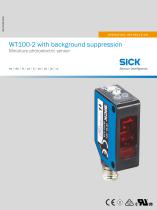
OPERATING INSTRUCTION WT100-2 with background suppression Miniature photoelectric sensor
Open the catalog to page 1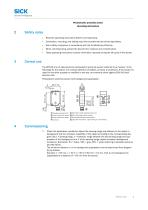
Sensor Intelligence. Photoelectric proximity sensor Operating instructions Read the operating instructions before commissioning. Connection, mounting, and setting may only be performed by trained specialists. Not a safety component in accordance with the EU Machinery Directive. When commissioning, protect the device from moisture and contamination. These operating instructions contain information required during the life cycle of the sensor. The WT100-2 is an opto-electronic photoelectric proximity sensor (referred to as "sensor" in the following) for the optical, non-contact detection of...
Open the catalog to page 2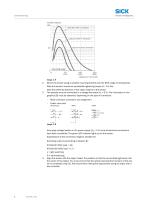
Commissioning Function reserve 100 white 90 %/90 % remission Operating range Distance in mm (inch) Image 1: H Mount the sensor using a suitable mounting bracket (see the SICK range of accessories). Note the sensor's maximum permissible tightening torque of < 0.5 Nm. Note the preferred direction of the object relative to the sensor. The sensors must be connected in a voltage-free state (VS = 0 V). The information in the graphics [B] must be observed, depending on the type of connection: – Male connector connection: pin assignment – Cable: core color Only apply voltage/switch on the power...
Open the catalog to page 3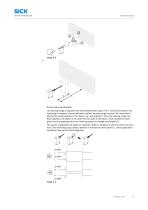
Sensor with potentiometer: The sensing range is adjusted with the potentiometer (type: 270°). Clockwise rotation: sen‐ sing range increased; counterclockwise rotation: sensing range reduced. We recommend placing the switching state in the object, e.g., see Graphic F. Once the sensing range has been adjusted, the object is removed from the path of the beam, which causes the back‐ ground to be suppressed and the switching output to change (see Graphic C). The sensor is adjusted and ready for operation. Refer to Graphics C and G to check the func‐ tion. If the switching output fails to behave...
Open the catalog to page 4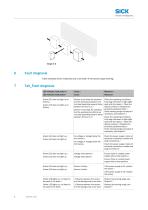
Fault diagnosis Table indicates which measures are to be taken if the sensor stops working. Tab_Fault diagnosis LED indicator/fault pattern / Green LED does not light up or flickers / Sensor is still ready for operation, but the operating conditions are not ideal (operating reserve factor between 0.9 and 1.1) / Green LED does not light up or flickers Green LED does not light up / Green LED does not light up Check the operating conditions: Fully align the beam of light (light spot) with the object. / Clean the optical surfaces / Readjust the Sensor is still ready for operation, sensitivity...
Open the catalog to page 5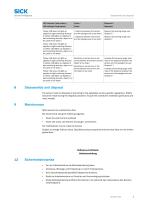
Yellow LED does not light up (applies to light switching devices) or yellow LED lights up (applies to dark switching devices), object is in the path of the beam / / Distance between the sensor and the background is too short / Reduce the sensing range, see Graphic F / / Distance between the sensor and the background is too short Reduce the sensing range, see Graphic F Yellow LED does not light up (applies to light switching devices) or yellow LED lights up (applies to dark switching devices), object is in the path of the beam Yellow LED does not light up (applies to light switching devices)...
Open the catalog to page 6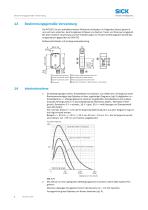
BestimmungsgemaBe Verwendung Sensor Intelligence. Die WT100-2 ist ein optoelektronischer Reflexions-Lichttaster (im Folgenden Sensor genannt) und wird zum optischen, beruhrungslosen Erfassen von Sachen, Tieren und Personen eingesetzt. Bei jeder anderen Verwendung und bei Veranderungen am Produkt verfallt jeglicher Gewahrleis- tungsanspruch gegenuber der SICK AG. 2 Den Sensor an einen geeigneten Befestigungswinkel montieren (siehe SICK-Zubehor-Pro- Maximal zulassiges Anzugsdrehmoment des Sensors von < 0.5 Nm beachten. Vorzugsrichtung des Objektes zum Sensor beachten [vgl. A].
Open the catalog to page 7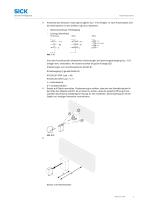
Anschluss der Sensoren muss spannungsfrei (VS = 0 V) erfolgen. Je nach Anschlussart sind die Informationen in den Grafiken [vgl. B] zu beachten: – Steckeranschluss: Pinbelegung – Leitung: Adernfarbe Erst nach Anschluss aller elektrischen Verbindungen die Spannungsversorgung (VS > 0 V) anlegen bzw. einschalten. Am Sensor leuchtet die grüne Anzeige-LED. Erläuterungen zum Anschlussschema (Grafik B): Schaltausgang Q (gemäß Grafik B): WT100-2P (PNP: Last -> M) WT100-2N (NPN: Last -> L+) L = hellschaltend 4 D = dunkelschaltend Sensor auf Objekt ausrichten. Positionierung so wählen, dass der rote...
Open the catalog to page 8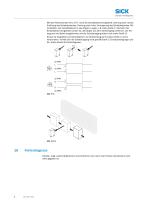
Mit dem Potentiometer (Art: 270°) wird der Schaltabstand eingestellt. Drehung nach rechts: Erhöhung des Schaltabstandes, Drehung nach links: Verringerung des Schaltabstandes. Wir empfehlen, den Schaltabstand in das Objekt zu legen, z.B. siehe Grafik F. Nachdem der Schaltabstand eingestellt worden ist, das Objekt aus dem Strahlengang entfernen, der Hin‐ tergrund wird dabei ausgeblendet und der Schaltausgang ändert sich (siehe Grafik C). Sensor ist eingestellt und betriebsbereit. Zur Überprüfung der Funktion Grafik C und G heranziehen. Verhält sich der Schaltausgang nicht gemäß Grafik C,...
Open the catalog to page 9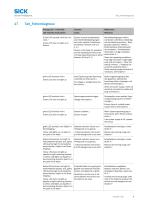
Tab_Fehlerdiagnose Anzeige-LED / Fehlerbild / Grüne LED leuchtet nicht bzw. fla‐ ckert / Sensor ist noch betriebsbereit, aber die Betriebsbedingungen sind nicht optimal (Funktionsre‐ servefaktor zwischen 0,9 und 1,1) / Green LED does not light up or flickers grüne LED leuchtet nicht / Green LED does not light up Betriebsbedingungen prüfen: Lichtstrahl (Lichtfleck) vollständig auf das Objekt ausrichten / Reini‐ gung der optischen Flächen / Empfindlichkeit (Potentiometer) Sensor is still ready for operation, neu einstellen / Schaltabstand überprüfen und ggf. anpassen, but the operating...
Open the catalog to page 10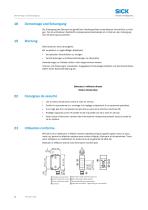
Sensor Intelligence. Die Entsorgung des Sensors hat gemaS den landerspezifisch anwendbaren Vorschriften zu erfol- gen. Fur die enthaltenen Wertstoffe (insbesondere Edelmetalle) ist im Rahmen der Entsorgung eine Verwertung anzustreben. SICK-Sensoren sind wartungsfrei. Wir empfehlen, in regelmaSigen Abstanden die optischen Grenzflachen zu reinigen Verschraubungen und Steckverbindungen zu uberprufen Veranderungen an Geraten durfen nicht vorgenommen werden. Irrtumer und Anderungen vorbehalten. Angegebene Produkteigenschaften und technische Daten stellen keine Garantieerklarung dar. Detecteur a...
Open the catalog to page 11All SICK SENSOR INTELLIGENCE catalogs and technical brochures
-
REGISTRATION SENSORS
24 Pages
-
CLV63x, CLV64x, CLV65x
102 Pages
-
WTB16 Bluetooth®
135 Pages
-
WE9LC-3_A71
3 Pages
-
Safety Switches
20 Pages
-
Automation light grids
8 Pages
-
Encoders and Inclination Sensors
32 Pages
-
Proximity Sensors
324 Pages
-
Dust measuring devices
172 Pages
-
Detection and Ranging Solutions
124 Pages
-
Distance Sensors
404 Pages
-
Vision
124 Pages
-
Top-Products from SICK
556 Pages
-
Fluid Sensors
243 Pages
-
Registration Sensors
276 Pages
-
Magnetic Cylinder Sensors
164 Pages
-
IDENTIFICATION SOLUTIONS
24 Pages
-
Our identification solutions
8 Pages
-
FLOWSIC300 Ultrasonic Gas Flow Meter
177 Pages
-
FLOWSIC300 Gas flow meters
12 Pages
-
FLOWSIC500 Gas flow meters
16 Pages
-
FLOWSIC600 Ultrasonic Gas Flow Meter
138 Pages
-
FLOWSIC600 Gas Flow Meter
16 Pages
-
ConVer
12 Pages
-
GM32 In-situ gas analyzers
28 Pages
-
GM35 In-Situ IR Gas Analyzer
16 Pages
-
Encoders
788 Pages
-
Opto Electronic Protective Devices
712 Pages
-
GMS800 Extractive Gas Analyzers
20 Pages
-
WT100-2 energetic
47 Pages
-
VPS Pro Profiling systems
20 Pages
-
Photoelectric Sensors
949 Pages
-
G6 - Global Sensor
20 Pages
-
Hand-Held Scanners IDMx
48 Pages














































